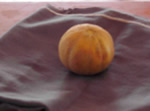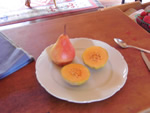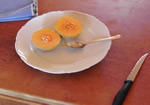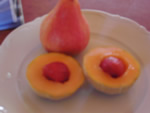Fastbreak Cantaloupe Success
by William P. Meyers
Popular Articles:
| Gardening |
| Movie Reviews |
| U.S. War Against Asia |
| Installing a Skylight |
| Marbling Paper |
| Corruption in the USA |
| Irradiated Food |
| Democratic Party |
| Republican Party |
I garden, therefore I am.
I love gardening. I have a challenging gardening situation on my land, which was once forest on top of the first ridge from the ocean in southern Mendocino county. The trees were cut, the land eroded, so the soil is thin at best. Most of my lot is being restored to redwoods and other native plants, but I have an area for fruit trees and vegetables.
I have struggled with the weather here. Winters, from about December to about April, are characterized by heavy rains, lows in the 40's, and highs in the 50's, but some times we get a dry stretch and we get some frosts, plus usually one freeze per year. The freeze means many tropical plants can survive only in greenhouses. Usually there is enough chill to set apples and pears, but not always.
Summers are dry and may have hot days or spells, but we get a lot of coastal "fog" which is usually cloud cover. Heat loving plants may not grow well or set fruit. So in the spring I grow cool weather crops like snow peas, potatoes, and lettuce.
Growing melons and squash is a problem. As usual I have neighbors with better soil or different microclimates that do better. I am at about 1100 feet above sea level. Go towards the ocean and down even 400 feet and you can avoid the winter freezes. Go inland and down a bit and it is much, much warmer. A two miles further inland it may be 20 or even 30 degrees warmer than it gets at my house.
I have harvested a few zucchini in several attempts the last few years, but not the kind of overwhelming crops others get. This year I decided to try something different. I planted Delicata squash, Babylon Cucumbers, and Fastbreak Cantaloupe. I thought the cantaloupe was the chanciest choice, but I was wrong.
I have all of one Delicata squash despite having 6 healthy plants. Mostly I got male flowers, and most female flowers did not develop. This summer was the coolest summer I can remember, with highs in the low 70's most of the summer. Usually we have occasional spells of 3 to 5 days of weather in the 80's or even 90's, which lets squash set.
The cucumbers just did not do well at all. Only two plants survived and they were stunted. They were in an area where I have not improved the soil as very much, but that was true of the cantaloupes to.
Here are some pictures of my cantaloupes (with a Rescue pear and strawberries):
 |
 |
 |
 |
Cut in half, the Fastbreak cantaloupe makes a nice individual serving. Add berries to the center for accent.
But the important thing for me was that despite the cool summer weather I got ripe, edible cantaloupe. I planted 8 seeds in four sets of two. Six sprouted. I pulled them back to three plants. 8 fruit were set, but two were damaged before harvest. So I got six cantaloupe.
The seeds came from Territorial Seed Company, which has lots of varieties that are supposed to grow on the northwest coast.
My cantaloupes varied from about three to about four inches in diameter and weighed from five to eleven ounces. Probably one of the reasons this melon ripens quickly is its small size. However, you may get larger melons if you have better soil or a more conducive climate. Territorial claims time to harvest is 69 days and that you get 5 to 6 inch diameter melons that weigh 4 to 5 pounds.
My Fastbreak melons were planted on May 7 and the first one was ripe on September 5, so it was about 4 months or 120 days from seeding to first fruit. I imagine that in most of the U.S., where summers are hotter, you could get ripe cantaloupes much earlier. Better still, further north on the Pacific Coast, you might get ripe melons as late as October.
